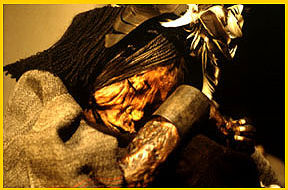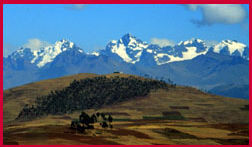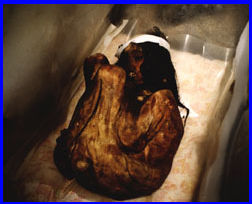
|
 |
 |
 The High Mummies
The High MummiesWritten By Liesl Clark Mummies of the World | The High Mummies | Preserving a Mummy | Sarita's Land High Sacrifice He has delicate fingers and hugs his knees, one foot over the other, as if to keep warm. His hair is plaited in more than 200 braids, and miniature idols and keepsakes accompany him in his frozen tomb. Dead for 500 years, this Inca sacrificial mummy found on Chile's El Plomo Peak has opened the door to further inquiry into the strange and mysterious ritual life of the Inca. There may be hundreds of Inca children, sacrificed in Inca times nearly 500 years ago, entombed in graves of ice atop the western hemisphere's highest peaks. To date, over 115 sacred Inca ceremonial sites have been excavated at an elevation over 15,000 feet on some 30 Andean peaks. These high mountain sanctuaries dot the Andes from central Chile to southern Peru. All of the sites are located in the region of the two southernmost Inca quarters, or "suyus," but only a few of these remote and icy summits have yielded finds of much archeological value. The discovery by Johan Reinhard of "Juanita," an Inca ice maiden found atop Mount Ampato in 1995, is the most recent—and some say the most revealing—addition to scientists' understanding of Inca life and culture.  Mountain Worship
Mountain WorshipThe Incas worshipped the high peaks that pierce the South American skies. These rugged summits represented a means of approaching the Sun God, Inti, the center of their religion, and many sacrifices were made atop these cold and unpredictable pinnacles. Mountain deities were seen as lords of the forces of nature who presided over crops and livestock. In essence they were the protectors of the Inca people, the keepers of life who reached up toward the skies where the sacred condor soared. Many theories exist about why the Incas performed ritual ceremonies, which sometimes included human sacrifices, at elevations approaching 23,000 feet. Most scholars agree that the purpose of the sacrifice, known as "capacocha," was to appease the mountain gods and to assure rain, abundant crops, protection, and order for the Inca people. Sacrifices often coincided with remarkable occasions: earthquakes, eclipses, droughts. On these occasions the Incas were required to offer valuables from the highest regions they could reach—the ice-clad summits of Andean peaks. Truly auspicious events, such as the death of an emperor, prompted human sacrifices, perhaps to provide an escort for the emperor on his journey to the Other World.  The fact that many high elevation sacrificial sites are
located near trans-mountain roads suggests that sacrifices
were also made in conjunction with the expansion of the Inca
civilization itself. The extensive roads in the southernmost
regions were integral to the expansion of the empire
southward. Especially important were the trans-mountain, or
east-west, roads, which linked north-south running ranges and
valleys over high-mountain passes. Near such routes, the Incas
chose high peaks, climbed them, built their platforms, and
made sacrifices, sometimes human, to assure safe continued
passage and to bless the roads. The mummy of a young boy on
Mount Aconcagua, discovered in 1985, could be one such
sacrifice. His tomb is near one of the most important
trans-mountain paths which today is virtually the same route
as the major international highway linking Argentina and
Chile.
The fact that many high elevation sacrificial sites are
located near trans-mountain roads suggests that sacrifices
were also made in conjunction with the expansion of the Inca
civilization itself. The extensive roads in the southernmost
regions were integral to the expansion of the empire
southward. Especially important were the trans-mountain, or
east-west, roads, which linked north-south running ranges and
valleys over high-mountain passes. Near such routes, the Incas
chose high peaks, climbed them, built their platforms, and
made sacrifices, sometimes human, to assure safe continued
passage and to bless the roads. The mummy of a young boy on
Mount Aconcagua, discovered in 1985, could be one such
sacrifice. His tomb is near one of the most important
trans-mountain paths which today is virtually the same route
as the major international highway linking Argentina and
Chile.Continue Photos: (1) courtesy Chris Openshaw; (2) courtesy Micheal Barnes; (3) courtesy Chris Openshaw. Expedition '96 | Dispatches | Mummies | Lost Worlds | Mail Resources | Site Map | Ice Mummies of the Inca Home | BBC Horizon Editor's Picks | Previous Sites | Join Us/E-mail | TV/Web Schedule About NOVA | Teachers | Site Map | Shop | Jobs | Search | To print PBS Online | NOVA Online | WGBH © | Updated November 2000 |